В.Кондратьев Самолеты первой мировой войны
ГАНЗА-БРАНДЕНБУРГ G-I / HANSA-BRANDENBURG G-I
Единственный серийный двухмоторный бомбардировщик, выпускавшийся в Австро-Венгрии, имел немецкое происхождение. В конце 1915 года авиаконструктор Эрнст Хейнкель, работавший в то время на фирме Ганза-Бранденбург, спроектировал двухмоторный бомбардировочный аэроплан G-I.
В начале 1916-го самолет прошел испытания, и им сразу же заинтересовалось австрийское военное командование. У австрийцев уже были налажены связи с фирмой, где они незадолго до этого приобрели лицензию на другую машину Хейнкеля - одномоторный разведчик "Ганза-Бранденбург" C-I, а также два прототипа двухмоторных бомбардировщиков, не пошедших в серию (обозначения - ZM и GF).
Вскоре на венгерском авиазаводе Унгариш Флюгцойгфабрик АГ (UFAG) началась лицензионная постройка бомбардировщика G-I, представлявшего собой улучшенный тип GF. Его конструкция во многом повторяла предыдущие разработки Эрнста Хейнкеля: деревянный фюзеляж с фанерной обшивкой, бипланная коробка с элеронами на верхнем крыле и характерными "заваленными" вовнутрь стойками.
Пилот и хвостовой стрелок размещались в общей кабине с большим овальным вырезом. В носовой кабинке сидел третий член экипажа - стрелок-бомбардир.
Оригинальной особенностью машины был способ установки двигателей. Очевидно, не имея опыта размещения силовых агрегатов на крыле, Хейнкель прикрепил моторы к лонжеронам фюзеляжа на длинных ажурных фермах из стальных труб. Конструкция получилась довольно громоздкой, тяжелой, да к тому же - подверженной вибрациям.
По первоначальному плану UFAG должен был построить 24 машины и еще 48 собирались заказать в Германии, но затем заказ уменьшили до 39 штук, из которых только 12 смонтировали в Венгрии. Некоторые серийные экземпляры отличались от других заостренной носовой законцовкой фюзеляжа. Кроме того, не у всех аппаратов двигатели были закапотированы.
В январе-феврале 1917-го самолеты поступили на вооружение одной из бомбардировочных эскадр итало-австрийского фронта.
Освоение машины сопровождалось многочисленными проблемами, в результате за три месяца фронтовой службы "Бранденбурги" совершили всего один успешный боевой вылет. В апреле все самолеты сдали на базы хранения.
Примерно тогда же австрийцы получили возможность ознакомиться с летно-техническими данными нового немецкого бомбардировщика "Гота" G-IV. Поскольку его показатели были заметно выше, чем у "Бранденбурга", выпуск машины Хейнкеля быстро свернули, а взамен приобрели три десятка "Гот".
Весной 1918-го G-I расконсервировали и попытались использовать как ночные бомбардировщики, но и в этом качестве они не преуспели. До конца войны "Бранденбурги" прослужили в учебных подразделениях.
ДВИГАТЕЛИ
2 160-сильных "Австро-Даймлера".
ВООРУЖЕНИЕ
2 пулемета "Шварцлозе" на горизонтальных полутурелях.
ЛЕТНО-ТЕХНИЧЕСКИЕ ХАРАКТЕРИСТИКИ
Размах, м 18,0
Длина, м 9,8
Площадь крыла, кв.м 70,0
Сухой вес, кг 1776
Взлетный вес, кг 2740
Скорость максимальная, км/ч 133
Время набора высоты, мин/м 30/3000
Экипаж, чел 3
C.Owers Hansa-Brandenburg Aircraft of WWI Vol.1: Landplanes (A Centennial Perspective on Great War Airplanes 17)
The 05.06 Bomber
Ordered in July 1915 this bomber was to have been powered by four 100-hp Mercedes engines mounted in push-pull configuration. This machine was completed to the stage where engine trials could be undertaken and these demonstrated the fragility of the structure. Flars blamed Heinkel as the structure of the almost completed machine was too weak, while the machine was grossly overweight. No specifications, photographs or plans of this machine have been found to date.
Type GF 05.08
Another prototype twin-engined biplane bomber for the Austro-Hungarians was ordered as an "improved" GF and was given the serial 05.08. This aircraft was of mixed construction with a steel-tube fuselage and conventional wire-braced wooden wings. The 160-hp Mercedes engines were supported from the central core of the fuselage and did not affect the wing cellule. 05.08 participated in several bombing raids but was apparently put out of action when returning home from a raid on 16 May 1916, Austro-Hungarian anti-aircraft gunners shot at the unfamiliar shape. This machine was similar in construction to the G.I bomber.
Type GF (Austro-Hungarian G.I)
Also designated GF, the G.I was the production model of the work that commenced with the ZM. The LFT were encouraged by the trials of the Brandenburg 05.05 to order 48 improved G.I bombers, half being constructed each by Brandenburg as the Series 62.5 and by UFAG as the Series 62. When it was apparent that the machines could not keep in the air with one engine the order was reduced to 39 machines. On receiving the first six from Brandenburg in June 1916 the shortcomings of the type were evident and Heinkel proposed installing a third engine in the nose but this was rejected. The landing gear was also a problem as it was too weak for operational use. Brandenburg refused to rectify the problems and this led to conflict with the Austro-Hungarian authorities that saw the LFT force Brandenburg to conduct all its financial dealings with the Austro-Hungarian military through Phonix.
Twin wheels were fitted to the machines but this did little to overcome their failings. By March 1917 Fluggeschwader 1 had received five Brandenburg and six UFAG built G.I bombers. Due to the fact that the UFAG machines were of higher constructional quality than the Brandenburg-built machines, these were modified in the field. The commander/bomb aimer's position was moved to the nose while a seat was provided back towards the cockpit to protect him in the case of a landing mishap. New bomb carriers and gun turrets were fitted. Despite these sterling efforts the G.I bombers of Fluggeschwader 1 only made one mission. During April-May 1917, all the G.I bombers were stripped and placed in storage while the argument raged between Brandenburg and the LFT over who should pay for the modifications to the aircraft.
Late in 1917 the decision was made to recondition the G.I bombers. Over 30 of the bombers were rebuilt by the Flars workshop and by Flugzeug Reparatur und Bau Anstalt. The machines were given strengthened engine mounts, the pilot's cockpit was moved forward for improved visibility, and horizontal bomb racks replaced the internal vertical racks. Bomb load was stated to be 160-300 kg of bombs. The modifications were not successful as the machines were tail heavy and required great strength to fly for any length of time. Landing accidents with fractured fuselages or landing gear were common. The type was used as a trainer. Gotha G.IV(LVG) bombers were obtained from Germany instead.(24)
One source suggests that Poland obtained one G.I bomber and possibly two.(25)
(24) See Herris, J. Gotha Aircraft of WWI, Aeronaut Books, USA, 2013.
(25) Cynk, J.B."Les Avions de L'Independence Polonaise," Le Fana de l'Aviation, No.171, Feb, 1984.
Brandenburg Type GF (Austro-Hungarian G.I) Specifications
Source Typenschau Brandenburg 3-view PMG Data Series 62.5 PMG Data Series 62 Typenschau UFAG G.I
Span, m 18.00 18.000 18.00/18.00 18.00/10.00* 18.00
Length, m - - 9.80 9.83 -
Height, m - - 3.60 3.75 -
Wing Area, m2 69.70 - 70 64.0 69.70
Wt. Empty, kg 1,760 - 1,776 - 1,400
Wt. Loaded, kg 2,640 - 2,740 - 2,120
Speed in km/hr 140 - 144 133 140
Time to 1000 m 8 min - 8 min 8 min 8 min
Time to 3000 m - - - - 6 hrs 30 min
Endurance - - - - -
Motor 160-hp Austro-Daimler 160-hp Austro - 160-hp Daimler 160-hp Austro-Daimler
* This dimension is incorrect as photographs show that the upper and lower wings have the same span.
Brandenburg G.I Production Orders
Serials Qty Mfr Order Date
62.01 - 06 6 UFAG July 7,1915
62.51 - 56 6 Brand. Dec. 12, 1915
62.57 - 77 21 Brand. Dec. 18, 1915
62.07 - 12 6 UFAG Feb. 25, 1916
P.Grosz, G.Haddow, P.Shiemer Austro-Hungarian Army Aircraft of World War One
Brandenburg 05.08
The LFT ordered an "improved Type GF" prototype bomber, designated 05.08 on 21 July 1915. Although adhering to the the basic GF layout, Heinkel reworked the 05.08 to incorporate the lessons learned from the frontline evaluation of the 05.05. Drawings, submitted to the LFT for approval in October 1915, show a robust steel-tube framework that comprised a central core from which engines, wings, undercarriage, and bombs were suspended. By concentrating the engine and undercarriage loads, the wing and fuselage structure was simplified and reduced in weight. The two 160 hp Mercedes were mounted completely independent of the wing cellule on a framework attached directly to the central core. Structurally, the 05.08 differed only slightly from the G.I series 62.5 bomber, for which a large production program was planned.
Records show that the 05.08 was assigned to Flik 19 for service evaluation in May 1916 and participated in several bombing raids. Returning from an attack on Udine (16 May 1916), Austro-Hungarian anti-aircraft troops, unfamiliar with the only twin-engined aircraft on the Isonzo Front, energetically peppered the airframe with shrapnel splinters. It was reported that the 05.08 was unable to remain aloft on one engine.
Brandenburg G.I(U) Series 62
On 31 July 1915, UFAG was given a contract to build six twin-engined bombers, powered by 160 hp Daimler engines, based on the Brandenburg 05.05/05.08 prototypes and contingent upon the successful completion of flight tests. Another six bombers were ordered on 25 February 1916, followed by 12 more in March 1916 in lieu of 24 Lohner B.VII(U) biplanes. The Flars representative reported slow progress in January 1916 and requested "definition of the next manufacturing steps." As described in the Brandenburg G.I series 62.5 chapter, the bomber was experiencing serious problems and in April 1916, the UFAG production order was reduced to 12 Brandenburg G.I(U) bombers, numbered 62.01 to 62.12.
The first production machine, 62.01, was 80 percent complete in March 1916, but technical problems and lack of interest delayed its completion until August 1916 when test pilot Oberleutnant Antal Lanyi-Lanczendorfer performed the maiden flight. After structural modifications required by Flars were finished in November 1916, three bombers were accepted. Six UFAG-built bombers were assigned to Fluggeschwader I in March 1917 but owing to intractable technical problems only one bombing attack was flown. See the Brandenburg G.I series 62.5 chapter for details.
Brandenburg G.I(U) Series 62 Specifications
Engine: 2 x 160 hp Daimler
Wing: Span Upper 18.00 m (59.05 ft)
Span Lower 10.00 m (32.81 ft)
Chord Upper 2.00 m (6.56 ft)
Chord Lower 2.00 m (6.56 ft)
Sweepback Upper 0 deg
Sweepback Lower 0 deg
Gap 2.00 m (6.56 ft)
Stagger 0.24 m (0.79 ft)
Total Wing Area 64.0 sq m (689 sq ft)
General: Length 9.83 m (32.25 ft)
Height 3.75 m (12.30 ft)
Track 2.50 m (8.20 ft)
Maximum Speed: 133 km/hr (83 mph)
Climb: 1000m (3,281 ft) in 8 min
3000m (9,843 ft) in 30 min
Brandenburg G.I Series 62.5
The outcome of the Brandenburg 05.05 trials at Flik 19, although prematurely terminated, encouraged the LFT to order production for 48 G.I bombers (Type GF) at Brandenburg and 24 at UFAG. By allocating the largest aircraft expenditure to date and by-passing extensive service trials, the LFT hoped to speed the introduction of a long-range bombing weapon. But in April 1916, Flars reported that "twin-engined aircraft were unfit for operational service because of their inability to remain aloft on one engine, making long-range missions impossible." In consequence, the production orders were cut back to 39 aircraft as follows:
Qty Series Number Manufacturer Order Date
6 62.01-06 UFAG 7 July 1915
6 62.51-56 Brandenburg 12 December 1915
21 62.57-77 Brandenburg 18 December 1915
6 62.07-12 UFAG 25 February 1916
Flars accepted the first six G.I series 62.5 bombers from Brandenburg in June 1916, but with serious reservations. Summoned to Aspern on 13 July 1916 to discuss the bomber's shortcomings, Heinkel and Ingenieur Brandenburg of UFAG were informed that the flight characteristics and structural strength, especially the weak undercarriage, were not equal to frontline standard. Heinkel's proposal to install a third engine in the nose was rejected. Hansa-Brandenburg refused to fix the problems and the G.I became an bone of acrimonious contention between the company and the LFT. Since the Hansa-Brandenburg company was located in Germany, outside the sphere of legal intervention, the LFT forced the Phonix company to assume full financial responsibility for Brandenburg's business dealings with the Austro-Hungarian military establishment.
Structurally the G.I was similar to the 05.08 prototype except that the engine mounts were simplified. Two 160 hp Daimler engines, fitted with the slanted Mercedes radiators, supplied the power. A bombardier-gunner was stationed in the nose turret; the pilot and rear gunner shared a common cockpit located aft of the center section. The bomb load consisted of five 50 kg (110 lb) and four 20 kg (44 lb) bombs. The G.I was first supplied in December 1916 to Fluggeschwader I (later Flik 101/G) based at Divacca on the Italian Front, reaching a total of five Brandenburg and six UFAG-built machines in March 1917. The undercarriage had been reinforced and fitted with twin wheels but little else had been done to prepare the bomber for operational service. LFT units were accustomed to performing frontline repairs, but in this instance they had their hands full. A furious squadron commander complained that "the required work went far beyond the normal duties expected of a newly-formed unit." Because UFAG-built bombers had superior workmanship, they were selected for the modification work. New bomb racks were designed and installed. Replacement gun turrets were fitted. The commander-bombardier's position was moved forward to the nose and a mid-section seat was installed to protect him and his "costly instruments" from a possible landing mishap. The bomb-release mechanism was relocated for easy accessibility. One can only applaud the skill and ingenuity of the squadron personnel, but in spite of their Herculean efforts only a single G.I bombing mission was recorded in the Fluggeschwader I war diary. In April-May 1917, all G.I bombers were placed in storage, stripped of engines, instruments, and tires, to await the outcome of the dispute between Flars and Brandenburg, who adamantly refused to pay for correcting the various deficiencies. In September 1917, an exasperated officer wrote "the over-hastily ordered G.I bombers languish at Aspern because none of the responsible authorities care a whit. The aircraft were accepted after only one test flight. Everyone is waiting for the argument to end."
In late 1917 when the Austro-Hungarian army reached the Piave, the army command requested night bombing attacks such as the German Bombengeschwader 4 had effectively demonstrated on the upper Italian Front. The LFT decided to rejuvenate the Brandenburg bombers, now in storage for almost a year. Between December 1917 and May 1918, over 30 G.I bombers were rebuilt by the Flars workshops and the Flugzeug Reparatur und Bau Anstalt (Fruba). They were fitted with horizontal bomb racks; the pilot's cockpit was moved forward to improve visibility, and the engine mountings were reinforced. The modified G.I was assigned to Fliks 101/G, 102/G, and 103/G, as well as Flek 22 in Strasshof. According to Flik 102/G "a weight lifter was required to fly the machine, it being beyond the capacity of a normal person to perform flights of long duration." The fully-loaded bomber was so tail heavy that it was difficult to get it off the ground. During landing, fuselage and tailskid fractures were not uncommon. At best the G.I was used as a twin-engined trainer in preparation for the imminent arrival of the Gotha G.IV (LVG) bomber from Germany.
Brandenburg G.I Series 62.5
Engine: 2 x 160 hp Daimler
Wing: Span Upper 18.00 m (59.05 ft)
Span Lower 18.00 m (59.05 ft)
Chord Upper 2.00 m (6.56 ft)
Chord Lower 2.00 m (6.56 ft)
Dihedral Upper 0.18 m (0.59 ft) at tip
Dihedral Lower 0.18 m (0.59 ft) at tip
Sweepback Upper 0 deg
Sweepback Lower 0 deg
Gap 2.10 m |6.89 ft)
Stagger 0.25 m (0.82 ft)
Total Wing Area 70.0 sq m (753 sq ft)
General: Length 9.80 m (32.15 ft)
Height 3.60 m (11.81 ft)
Track 2.55 m (8.37 ft)
Empty Weight 1776 kg (3916 lb)
Loaded Weight 2740 kg (6042 lb)
Maximum Speed: 144 km/hr (89 mph)
Climb: 1000m (3,281 ft) in 8 min
Brandenburg G.I Equipped With Searchlight
Two Brandenburg G.I bombers, 62.76 and 62.77, were retained at Briest for installation of a 15,000-candlepower Goerz 600 mm searchlight
mounted behind the rear cockpit. Electrical power was supplied by a 5 kw dynamo. A control wheel allowed the forward observer to rotate the gimballed light in all axes. The pilot's seat was moved forward and German PuW bomb racks for horizontal storage were installed. During night tests with a Brandenburg G.I carrying a 9000 candlepower searchlight, ground targets were readily identified from 1500 meters (4622 ft). For navigational purposes, the wind direction and velocity (i.e., drift) could be calculated with fair accuracy by observing the terrain. Contrary to expectations, the searchlight proved unsuitable for night landing. Wing lights were more suitable. Aircraft 62.76 and 61.17, powered by 185 hp Daimler and 200 hp Hiero engines respectively, were shipped to Aspern on 3 August 1917, and reported ready for flight tests in November. Further details are lacking.
Brandenburg G.I with Cannon Armament
In early 1916, Flars engineer Oberleutnant Dr. Leopold Kann visited Germany to discuss arming a G.I bomber with a cannon and to inspect similar Idflieg experiments. Flars had chosen a 7cm Skoda cannon firing a high-explosive shell at a muzzle velocity of 235 meters/second (771 ft/sec). The elevation range was 35 degrees and the traverse slightly less. Rather large for aircraft use, the cannon's weight of 200 kg (441 lb) gave the gunner a handful. On 20 June 1916, the cannon was mounted in aircraft 62.54 (Type GF Spezial). The aircraft was delivered to Fischamend for firing trials where, according to Antal Feher's flight log, the first flight was performed on 4 March 1917 (no cannon was mentioned) - an indication that the project was proceeding slowly. In August 1918, the 62.54 was at the Fruba factory for modification as a trainer. However, cannon experiments continued. A new Skoda mounting, intended for installation in aircraft 62.62, was tested in late June 1918. Further details are lacking.
An Explanatory Note About Hansa-Brandenburg Serial Numbers:
When the LFT assigned new serial numbers to aircraft in February 1915, Hansa-Brandenburg was assigned the company designation 05. The first nine numbers, 05.01 to 05.09, were allocated to out-of-series or prototype aircraft. Series production aircraft began with the Hansa-Brandenburg B.I 05.11. At a later date, production aircraft were numbered 61.5 and up and prototype aircraft were assigned numbers beginning with 60.5. To avoid confusion, the table shows the series designations assigned to Brandenburg and UFAG, although the types were not identical nor were parts interchangeable:
Type UFAG Hansa-Brandenburg
Brand C.I 61.01-24 61.51-72
Brand G.I 62.01-12 62.51-77
Brand C.I 63.01-32 63.51-86
Brand C.I 64.01-48 64.51-72
Brand D.I not built by UFAG 65.50-99
Brand C.II 66.01 (cancelled) 66.51 (two built)
Brandenburg 05.06
In July 1915 Hansa-Brandenburg was authorized to begin design and construction of a large bomber designated 05.06 and powered by four 100 hp Mercedes engines mounted in a push-pull configuration. On 23 November 1915, the resident inspector reported the wings and fuselage were ready and expected final completion on 1 December 1915. The formal contract was signed on 6 March 1916, specifying a bomber powered by four 160 hp Mercedes engines, capable of carrying six 50 kg (110 lb) bombs at a speed of 135 km/hr (84 mph). The increase in engine power required additional interior bracing and heavier spreader tubes and spar fittings. Throughout the remainder of the year, work was at a virtual standstill, for which Flars later blamed Heinkel, claiming "he realized the project was doomed to fail and stopped work on it."
On 29 March 1917, when Oberleutnants Kamillo Korner and Theodor von Karman of Flars inspected the nearly finished 05.06 airframe, they found that the contractual empty weight had increased by 1381 kg (3045 lb). The three crewmen (reduced from four), fuel, oil, and water, but not including bombs, would bring the flying weight to 4621 kg (10,189 lb), a figure which placed the required safety factor beyond reach. To Karman "it was obvious that the wings and fuselage were much too weak...also the tail structure appears very fragile." All interior fittings showed serious deficiencies although the engine bearers appeared robust enough. During the engine trials the rear fuselage vibrated dangerously. Deemed that it was far removed from serving any useful role, Korner and Karman advised against reconstruction or acceptance of the aircraft. Eventually Flars did pay Kr 60,180 ($ 11,846) in cancellation fees.
Both the Hansa-Brandenburg aircraft catalog of 1922 and Heinkel's postwar publicity brochures fail to mention the ill-fated 05.06 project, nor have drawings or specifications been found in extant archives.
Brandenburg 60.54
On 16 March 1916, Brandenburg received a contract for an experimental three-man bomber powered by a 300/345 hp Daimler V-12 engine buried in the fuselage. The engine was connected to reduction gearbox connected to two propeller drive shafts. Flars felt the project would provide useful information of a configuration where the "propellers were neither in front nor behind the engine." Under the revised designation scheme, the prototype number assigned to this obscure project was 60.54.
Fuselage assembly was under way in May 1916 but the resident Flars inspector doubted that the 15 June delivery date could be met. When the completed fuselage and engine installation was inspected in July, it was discovered that "by virtue of the centrally-mounted engine, faulty exhaust evacuation presented a serious fire hazard." Construction moved at a leisurely pace until October 1916 when work ceased entirely. In March 1917, Flars attempted to pressure Brandenburg into finishing the aircraft, but to no avail and the project was cancelled. The 60.54 prototype is not mentioned in the post-war Hansa-Brandenburg literature nor have drawings or specifications been found.
E.Hauke, W.Schroeder, B.Totschinger Die Flugzeuge der k.u.k. Luftfahrtruppe und Seeflieger 1914-1918
01. - 010. Flugzeuge ausländischer Produktion (Самолеты иностранного производства)
05.06 Brandenburg G 4 x Merc 160
05.08 Brandenburg G (Type ZM) 2 x Merc 160
60. Flugzeuge der Ungarischen Flugzeugfabrik A.G. (Ufag) Budapest und Hansa Brandenburgische Flugzeugfabrik Brandenburg/Briest
60.54 Brandenburg DD Getriebeflugzeug Dm 300
62.01 — 62.12 Brandenburg G.I (U) 2 x Dm 160
62.51 — 62.77 Brandenburg G.I (Br) 2 x Dm 160
 |
В.Кондратьев - Самолеты первой мировой войны
|
| Hansa Brandenburg G-I (62.01), ВВС Австро-Венгрии, 1916г.
|
 |
E.Hauke, W.Schroeder, B.Totschinger - Die Flugzeuge der k.u.k. Luftfahrtruppe und Seeflieger 1914-1918
|
| Hansa-Brandenburg G I 62.01 Wr. Neustadt
|
 |
E.Hauke, W.Schroeder, B.Totschinger - Die Flugzeuge der k.u.k. Luftfahrtruppe und Seeflieger 1914-1918
|
| Brandenburg G.I
|
 |
C.Owers - Hansa-Brandenburg Aircraft of WWI. Volume 1 - Landplanes /Centennial Perspective/ (17)
|
| Brandenburg G.I(U) 62.07
|
 |
P.Grosz, G.Haddow, P.Shiemer - Austro-Hungarian Army Aircraft of World War One /Flying Machines/
|
| Brandenburg G.I(U) 62.08, Fluggeschwader I
|
 |
В.Обухович, А.Никифоров - Самолеты Первой Мировой войны
|
| Ганза-Бранденбург G I
|
 |
C.Owers - Hansa-Brandenburg Aircraft of WWI. Volume 1 - Landplanes /Centennial Perspective/ (17)
|
The Brandenburg 05.08, prototype for the G.I bomber, in the spring of 1916. The improved undercarriage and engine suspension are clearly shown. The engine mount was modified in the production version.
The sole Brandenburg 05.08 was an intermediate step between the 05.05 prototype and the production Brandenburg G.I.
|
 |
P.Grosz, G.Haddow, P.Shiemer - Austro-Hungarian Army Aircraft of World War One /Flying Machines/
|
Brandenburg G.I(U) 62.01 in August 1916 with the single-wheeled undercarriage, large, tapered engine cowlings, and rear-mounted radiators. The first UFAG-built bomber was accepted in November 1916.
Note the scalloped effect of the trailing edge on this G.I. This is caused by the fabric on top of the wing not being taken back to the rear edge of the wing and the light shining through the one layer on the bottom of the wing.
|
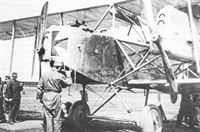 |
C.Owers - Hansa-Brandenburg Aircraft of WWI. Volume 1 - Landplanes /Centennial Perspective/ (17)
|
| This UFAG-built G.I has only the single-wheel undercarriage (one wheel per side).
|
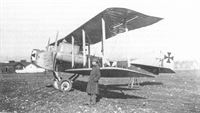 |
C.Owers - Hansa-Brandenburg Aircraft of WWI. Volume 1 - Landplanes /Centennial Perspective/ (17)
|
| Another view of UFAG-built Brandenburg G.I(U) 62.01, the first of an order for six machines placed on 7 July 1915.
|
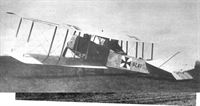 |
E.Hauke, W.Schroeder, B.Totschinger - Die Flugzeuge der k.u.k. Luftfahrtruppe und Seeflieger 1914-1918
|
| The first UFAG-built Brandenburg G.I was G.I(U) 62.01, the first of an order for six machines placed on 7 July 1915. It had a single-wheel undercarriage and the radiators were mounted to the rear of the tapered engine nacelles.
|
 |
P.Grosz, G.Haddow, P.Shiemer - Austro-Hungarian Army Aircraft of World War One /Flying Machines/
|
| The Brandenburg G.I(U) 62.01 modified with a twin-wheeled undercarriage and cut-back engine cowlings. This aircraft remained attached to the training command.
|
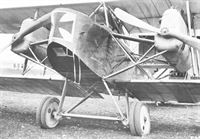 |
P.Grosz, G.Haddow, P.Shiemer - Austro-Hungarian Army Aircraft of World War One /Flying Machines/
|
| Brandenburg G.I(U) 62.01. The twin-wheeled undercarriage shows signs of overload. The flexible entry ladder is an incongruous touch, illustrative of the deficient design of this aircraft.
|
 |
C.Owers - Hansa-Brandenburg Aircraft of WWI. Volume 1 - Landplanes /Centennial Perspective/ (17)
|
| Engine testing a Brandenburg G.I series 62.5 on the Fluggeschwader I airfield at Divacca in early 1917. The undercarriage has been reinforced with heavy wire bracing and twin wheels were mounted.
|
 |
P.Grosz, G.Haddow, P.Shiemer - Austro-Hungarian Army Aircraft of World War One /Flying Machines/
|
Серийные "Бранденбурги" G-I венгерской постройки.
Brandenburg G.I(U) 62.08 on the Fluggeschwader 1 airfield at Divacca in March 1917. Like the Brandenburg C.I, the wing struts are canted. The fabric-wrapped wing struts were characteristic of the UFAG-built G.I.
|
 |
P.Grosz, G.Haddow, P.Shiemer - Austro-Hungarian Army Aircraft of World War One /Flying Machines/
|
| A Brandenburg G.I (62.54?) in the final assembly hall at Briest. At a later date the position of the radiator was shifted to the rear of the engine nacelle.
|
 |
E.Hauke, W.Schroeder, B.Totschinger - Die Flugzeuge der k.u.k. Luftfahrtruppe und Seeflieger 1914-1918
|
Brandenburg G.I 62.54 was part of the first Brandenburg-built production batch of G.I bombers ordered on 12 December 1915 and accepted in June 1916. Numerous problems with these aircraft resulted in bitter arguments between Brandenburg and the LFT.
Brandenburg G.I, Flugzeugnummer 62.54. Waffenversuchsflik des Fliegerarsenals, versuchsweiser Einbau einer 7 cm-Kanone, später Übungsflugzeug
Brandenburg G.I, номер 62.54. Испытательный корпус авиационного арсенала, экспериментальная установка 7-см пушки, позже учебный самолет
|
 |
В.Обухович, А.Никифоров - Самолеты Первой Мировой войны
|
|
|
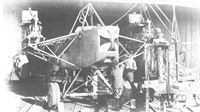 |
P.Grosz, G.Haddow, P.Shiemer - Austro-Hungarian Army Aircraft of World War One /Flying Machines/
|
| A Brandenburg G.I(U) being assembled at Fluggeschwader I in Divacca in March 1917. That the engines were mounted independent of the wing structure is the sole technical feature deserving mention.
|
 |
C.Owers - Hansa-Brandenburg Aircraft of WWI. Volume 1 - Landplanes /Centennial Perspective/ (17)
|
A dark-colored G.I serves as a backdrop for a group photo.
The Brandenburg G.I was originally delivered with the Mercedes radiators mounted in front of the nacelle but were later moved to the rear to improve cooling efficiency. The over-the-wing gravity tank was fitted only to a few bombers.
|
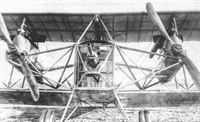 |
C.Owers - Hansa-Brandenburg Aircraft of WWI. Volume 1 - Landplanes /Centennial Perspective/ (17)
|
| Installation of the 7 cm Skoda cannon in the G.I required a substantial mount for the weapon. Photographs taken in July 1918. Note the cylindrical magazine. A Schwarzlose M7/12 was mounted over the cannon in order to enable the gunner to line up his target. The front gunner's position was reduced in order to fit the weapon mounted in the extreme nose. The gunner's position must have been very restricted.
|
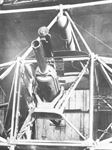 |
P.Grosz, G.Haddow, P.Shiemer - Austro-Hungarian Army Aircraft of World War One /Flying Machines/
|
| Close-up of the Brandenburg G.I 62.54 on 29 July 1918. A Schwarzlose M 7/12 machine gun, mounted over the cannon barrel, fired tracer ammunition to facilitate gun training. The gunner’s position appears very cramped.
|
 |
C.Owers - Hansa-Brandenburg Aircraft of WWI. Volume 1 - Landplanes /Centennial Perspective/ (17)
|
|
|
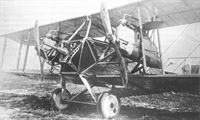 |
C.Owers - Hansa-Brandenburg Aircraft of WWI. Volume 1 - Landplanes /Centennial Perspective/ (17)
|
| Another view of the 7cm Skoda cannon and Schwarzlose M 16 machine gun mounted in the Brandenburg G.I 62.54. To what extent air firing trials were performed is not known.
|
 |
P.Grosz, G.Haddow, P.Shiemer - Austro-Hungarian Army Aircraft of World War One /Flying Machines/
|
| The Brandenburg G.I 62.54 with the 7 cm Skoda cannon installed and an aiming sight projecting through the gunner’s window. Twin wheels have been fitted.
|
 |
P.Grosz, G.Haddow, P.Shiemer - Austro-Hungarian Army Aircraft of World War One /Flying Machines/
|
| The Brandenburg G.I 62.54 shown here at Briest with a cannon (or mock-up) mounted in a movable turret fitted with a triangular Cellon aiming window for the gunner.
|
 |
C.Owers - Hansa-Brandenburg Aircraft of WWI. Volume 1 - Landplanes /Centennial Perspective/ (17)
|
| G.I 62.54 at Briest. The barrel of the cannon (or mock-up) projected from the nose of the modified bomber in a movable mounting.The gunner's Cellon aiming window may be seen above the cannon's barrel. Single wheels are still fitted.
|
 |
C.Owers - Hansa-Brandenburg Aircraft of WWI. Volume 1 - Landplanes /Centennial Perspective/ (17)
|
| This is thought to be 62.54 without the 7 cm Skoda cannon installed. The machine now has the double wheels each side of the undercarriage.
|
 |
C.Owers - Hansa-Brandenburg Aircraft of WWI. Volume 1 - Landplanes /Centennial Perspective/ (17)
|
| The 7-cm Skoda cannon fitted in the nose of a modified G.I bomber in a movable mounting. The gunner's Cellon aiming window above the cannon's barrel gave a very limited field of view. Dual wheels are now fitted.
|
 |
P.Grosz, G.Haddow, P.Shiemer - Austro-Hungarian Army Aircraft of World War One /Flying Machines/
|
| In the blurred background, the Aviatik 30.39 prototype was photographed by chance through the wings of an overturned Brandenburg G.I bomber.
|
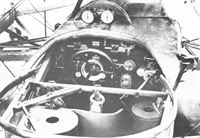 |
P.Grosz, G.Haddow, P.Shiemer - Austro-Hungarian Army Aircraft of World War One /Flying Machines/
|
| Brandenburg G.I(U) 62.01. The pilot’s cockpit and rear gunner’s turret with the round bomb containers installed at random positions in the fuselage, probably as an afterthought. The tachometers are mounted behind the windscreen. The pilot’s view of the terrain while landing was totally obscured by the lower wing.
|
 |
C.Owers - Hansa-Brandenburg Aircraft of WWI. Volume 1 - Landplanes /Centennial Perspective/ (17)
|
| Close-up photo of the rear cockpit of an early G.I.
|
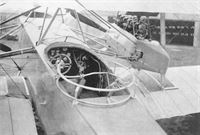 |
P.Grosz, G.Haddow, P.Shiemer - Austro-Hungarian Army Aircraft of World War One /Flying Machines/
|
| A close-up of the 05.08 prototype shows that the mid-fuselage observer’s cockpit of the 05.05 has been eliminated, although the poorly-situated pilot's cockpit has been retained.
|
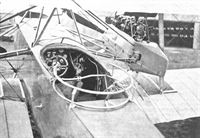 |
C.Owers - Hansa-Brandenburg Aircraft of WWI. Volume 1 - Landplanes /Centennial Perspective/ (17)
|
| The cockpit of Brandenburg 05.08 was well aft like the cockpit of 05.05, but now the engines were cowled.
|
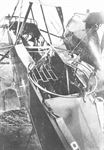 |
C.Owers - Hansa-Brandenburg Aircraft of WWI. Volume 1 - Landplanes /Centennial Perspective/ (17)
|
| Close-up of a modified Brandenburg G.I with the forward pilot’s cockpit, standard PuW bomb racks, and open fuselage passage.
|
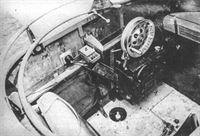 |
C.Owers - Hansa-Brandenburg Aircraft of WWI. Volume 1 - Landplanes /Centennial Perspective/ (17)
|
| Close-up photograph of the rear cockpit of a G.I bomber shows the gunner's seat, gun ring, and equipment.
|
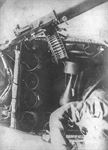 |
C.Owers - Hansa-Brandenburg Aircraft of WWI. Volume 1 - Landplanes /Centennial Perspective/ (17)
|
| Bomb, vertical bomb racks, and machine gun in the front cockpit of an early G.I.
|
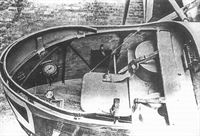 |
C.Owers - Hansa-Brandenburg Aircraft of WWI. Volume 1 - Landplanes /Centennial Perspective/ (17)
|
| Close-up photograph of the front cockpit of a G.I bomber shows the bombardier/gunner's seat and equipment.
|
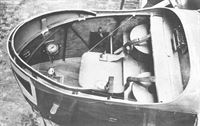 |
P.Grosz, G.Haddow, P.Shiemer - Austro-Hungarian Army Aircraft of World War One /Flying Machines/
|
| The bombardier’s position in the Brandenburg G.I(U) 62.01. The bomb release triggers are mounted on the shelf above the bomb tubes. Also seen are a clipboard holder, a gimballed compass, and a tripod to hold the bomb-sight above the aiming door. The bombardier was too far removed from the pilot for efficient communication, even if a speaking tube was installed.
|
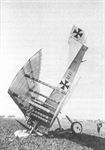 |
C.Owers - Hansa-Brandenburg Aircraft of WWI. Volume 1 - Landplanes /Centennial Perspective/ (17)
|
| G.I 62.07, first machine of the 2nd order from UFAG of 25 February 1916. The weak undercarriage caused this accident. The engine cowlings were usually removed for flight operations.
|
 |
P.Grosz, G.Haddow, P.Shiemer - Austro-Hungarian Army Aircraft of World War One /Flying Machines/
|
| Brandenburg G.I(U) 62.07 demonstrating the danger to which the nose gunner was exposed because of the weak undercarriage. Flight operations were generally performed with the engine cowlings removed.
|
 |
C.Owers - Hansa-Brandenburg Aircraft of WWI. Volume 1 - Landplanes /Centennial Perspective/ (17)
|
| Undercarriage collapse on a snow-patched airfield. This aircraft, 62.56, was among the 30 modified in late 1917 - early 1918. The pilot’s cockpit has been moved forward for better visibility, judging by the incomplete national markings, it appears the ailerons have been replaced. Despite the dual wheels, landing gear failure remained a constant problem with the G.I.
|
 |
C.Owers - Hansa-Brandenburg Aircraft of WWI. Volume 1 - Landplanes /Centennial Perspective/ (17)
|
| G.I 62.56 is shown in embarrassing circumstances, but now it has been wrecked, perhaps by a severe windstorm as indicated by the destroyed hangar in the background.
|
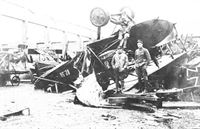 |
P.Grosz, G.Haddow, P.Shiemer - Austro-Hungarian Army Aircraft of World War One /Flying Machines/
|
| Seven Brandenburg G.I bomber-trainers, including 62.56, were destroyed in a fierce storm on 23/24 September 1918 in northern Italy.
|
 |
C.Owers - Hansa-Brandenburg Aircraft of WWI. Volume 1 - Landplanes /Centennial Perspective/ (17)
|
| The cause of this accident to the G.I can be seen to have been the weak landing gear, even with the dual wheels fitted each side.
|
 |
P.Grosz, G.Haddow, P.Shiemer - Austro-Hungarian Army Aircraft of World War One /Flying Machines/
|
| Brandenburg G.I(U) 62.08, Fluggeschwader I
|
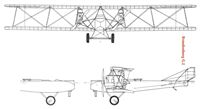 |
C.Owers - Hansa-Brandenburg Aircraft of WWI. Volume 1 - Landplanes /Centennial Perspective/ (17)
|
| Brandenburg G.I
|
 |
C.Owers - Hansa-Brandenburg Aircraft of WWI. Volume 1 - Landplanes /Centennial Perspective/ (17)
|
| Brandenburg G.I
|
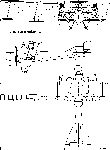 |
В.Кондратьев - Самолеты первой мировой войны
|
| "Ганза-Бранденбург" G-I
|
 |
P.Grosz, G.Haddow, P.Shiemer - Austro-Hungarian Army Aircraft of World War One /Flying Machines/
|
| Brandenburg G.I(U) 62.01
|



















































